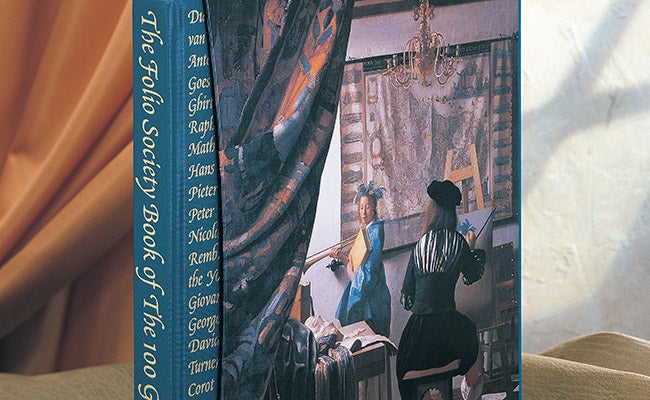Library Stories: Edward Halpern
In Library Stories we investigate the tales behind your book collections and book rooms, visiting the homes of Folio members, collectors and enthusiasts from around the world. If you have a Library Story you would like to share, please email us at social@foliosociety.com.
This month, artist and keen book-collector Edward Halpern from Spring Grove Illinois shares details of his extensive library, as well as the stories behind some of the objects that share space with his books.
FS: Before we start, I must ask you about some of the quite magnificent objects in your library. For instance, please tell us about your majestic elephant, and your ruminating Alice. You also mentioned two interesting plaques.
EH: My wife and I originally saw a herd of wooden elephants in 13 different sizes, from baby to very mature size, at the flagship store of Marshall Field & Company on State Street in Chicago, in 1986. They were made out of monkey wood in Thailand. I contacted the Embassy of Thailand in Washington, and eventually found the original manufacturer. The elephant, weighing 800 pounds, was shipped to us and arrived on February 19, 1988. I cleared it through customs in Chicago after the authorities drilled a hole in the bottom to be sure that no drugs were inside. The manufacturer had a great sense of humor as they put a bag of peanuts in the crate for the trip to the States.
 The statue of Alice in Wonderland is an original sculpture from the work of R. Stewart Inc. I have a pristine copy of Through the Looking Glass in blue leather, slipcased in red, published in 1935. It was a First Edition by the Limited Edition Club, and signed by the original Alice Hargreaves, who the book was written about.
The statue of Alice in Wonderland is an original sculpture from the work of R. Stewart Inc. I have a pristine copy of Through the Looking Glass in blue leather, slipcased in red, published in 1935. It was a First Edition by the Limited Edition Club, and signed by the original Alice Hargreaves, who the book was written about.
 The first plaque is ‘Temple Bar in Dr. Johnson’s Time’, and the second is ‘The Old Curiosity Shop, London’. Both are Ivorex plaques made in Faversham, Kent between 1899 and 1965 by the B. Osborne Company. Other plaques were made of cathedrals, churches, famous places and people both historical and fictional. Good luck if you can find them!
The first plaque is ‘Temple Bar in Dr. Johnson’s Time’, and the second is ‘The Old Curiosity Shop, London’. Both are Ivorex plaques made in Faversham, Kent between 1899 and 1965 by the B. Osborne Company. Other plaques were made of cathedrals, churches, famous places and people both historical and fictional. Good luck if you can find them!
 FS: You have a beautiful library. Could you tell us a little about its history? When did you first start collecting books?
EH: We started our library 40 years ago. Most of our books are housed in hardwood oak cases. From a 28-room mansion that was torn down in Chicago to put up a high-rise, I purchased hand-carved oak mouldings which I had removed from the ceiling of the ballroom. These are convex carved strips (circa 1900) of birds, serpents, squirrels, leaves and twigs now in the decoration at the top of our bookcases. We have all but 5 titles of the 548 titles of the Limited Edition Club books published in the original period of 1929 through 1985. We also have many additional titles published after 1985, which until they ceased publishing a few years ago were mostly produced at a rate of three or four a year.
FS: You have a beautiful library. Could you tell us a little about its history? When did you first start collecting books?
EH: We started our library 40 years ago. Most of our books are housed in hardwood oak cases. From a 28-room mansion that was torn down in Chicago to put up a high-rise, I purchased hand-carved oak mouldings which I had removed from the ceiling of the ballroom. These are convex carved strips (circa 1900) of birds, serpents, squirrels, leaves and twigs now in the decoration at the top of our bookcases. We have all but 5 titles of the 548 titles of the Limited Edition Club books published in the original period of 1929 through 1985. We also have many additional titles published after 1985, which until they ceased publishing a few years ago were mostly produced at a rate of three or four a year.
 FS: There is quite a mix of subjects. Do you have any particular areas of interest, or do you concentrate more on quality of edition? You mentioned you have quite a few British history volumes.
EH: We have approximately 200 titles from the publisher A & C Black, in the 20, 10, 8, and 6 shilling sizes, with about half in the sought-after 20 shilling size. We have a large leather-bound collection, including titles such as The Three Tours of Dr. Syntax and the same title in miniature, called at the time ‘the cheap edition’. Other highlights include Essays of Elia, The Monk by Matthew Lewis, Coaching Days & Coaching Ways by W. O. Tristram, Our Village by Mary Russell Mitford and many other gold gilt, green cloth hardcovers from the period 1865 – 93, all in near pristine condition. As every collector knows, condition is everything.
FS: There is quite a mix of subjects. Do you have any particular areas of interest, or do you concentrate more on quality of edition? You mentioned you have quite a few British history volumes.
EH: We have approximately 200 titles from the publisher A & C Black, in the 20, 10, 8, and 6 shilling sizes, with about half in the sought-after 20 shilling size. We have a large leather-bound collection, including titles such as The Three Tours of Dr. Syntax and the same title in miniature, called at the time ‘the cheap edition’. Other highlights include Essays of Elia, The Monk by Matthew Lewis, Coaching Days & Coaching Ways by W. O. Tristram, Our Village by Mary Russell Mitford and many other gold gilt, green cloth hardcovers from the period 1865 – 93, all in near pristine condition. As every collector knows, condition is everything.
 FS: Do you have a favourite Folio edition? How and when did you first come across Folio?
EH: I first found out about The Folio Society when I acquired an early catalogue. I was impressed by the professionalism of the company and the beautiful books that it consistently puts out.
Two Folio Society titles that I am quite fond of are The Folio Society Book of the 100 Greatest Paintings and The Vicar of Wakefield, a very early publication by Folio illustrated by Margaret Wetherbee. It is sort of a little treasure for me that is not available on any booksellers sites that I could find, and a great story by Oliver Goldsmith.
FS: Do you have an edition that you particularly value?
EH: I am in the early stages of considering your two-volume limited edition set Japan, one of the most opulent books you have ever published. The Far East has always been of interest to me. I have many related titles including a very rare book made of crepe paper – Sword & Blossom Poems by T. Hasegawa, featuring 17 double-folded pages with colour woodblock illustrations by Japanese artists.
One of our most valued editions is The Haggadah, which means ‘the telling’ in Hebrew, executed by Arthur Szyk. It is like an illuminated manuscript supplemented by borders, color illustrations and decorated initials. It came to life and was put together as Adolph Hitler was rising to power in Germany. It is sheer beauty combined with political symbolism. It was published in 1940 by Britain’s Beaconsfield Press, in a run of just 250 copies. Two copies of this edition were offered on Abe Books at close to $60,000 each. Another beautiful edition of this book has the Star of David on the front cover and a candelabrum on the back cover, all in Mother of Pearl.
Our miniatures are a special section within our overall collection. Around half are leather-bound and about 20% have hand-colored plates. Miniature Books by Louis W. Bondy was and still is one of the most important references on the subject. There is a Miniature Book Society, which has many members who own private small presses and produce books regularly. One such is the Figment Press of Mill Valley in California. Their book, (we have it!) A Carrousel opens completely around to show a Merry-go-round of horses and a button to push to hear Lullaby and Good Night.
FS: Do you have a favourite Folio edition? How and when did you first come across Folio?
EH: I first found out about The Folio Society when I acquired an early catalogue. I was impressed by the professionalism of the company and the beautiful books that it consistently puts out.
Two Folio Society titles that I am quite fond of are The Folio Society Book of the 100 Greatest Paintings and The Vicar of Wakefield, a very early publication by Folio illustrated by Margaret Wetherbee. It is sort of a little treasure for me that is not available on any booksellers sites that I could find, and a great story by Oliver Goldsmith.
FS: Do you have an edition that you particularly value?
EH: I am in the early stages of considering your two-volume limited edition set Japan, one of the most opulent books you have ever published. The Far East has always been of interest to me. I have many related titles including a very rare book made of crepe paper – Sword & Blossom Poems by T. Hasegawa, featuring 17 double-folded pages with colour woodblock illustrations by Japanese artists.
One of our most valued editions is The Haggadah, which means ‘the telling’ in Hebrew, executed by Arthur Szyk. It is like an illuminated manuscript supplemented by borders, color illustrations and decorated initials. It came to life and was put together as Adolph Hitler was rising to power in Germany. It is sheer beauty combined with political symbolism. It was published in 1940 by Britain’s Beaconsfield Press, in a run of just 250 copies. Two copies of this edition were offered on Abe Books at close to $60,000 each. Another beautiful edition of this book has the Star of David on the front cover and a candelabrum on the back cover, all in Mother of Pearl.
Our miniatures are a special section within our overall collection. Around half are leather-bound and about 20% have hand-colored plates. Miniature Books by Louis W. Bondy was and still is one of the most important references on the subject. There is a Miniature Book Society, which has many members who own private small presses and produce books regularly. One such is the Figment Press of Mill Valley in California. Their book, (we have it!) A Carrousel opens completely around to show a Merry-go-round of horses and a button to push to hear Lullaby and Good Night.
 FS: Many members tell us that one of the main problems they encounter with book collecting is the issue of space, with some moving parts of their collection into storage, and some even physically extending their homes. Have you had any issues with running out of room for books?
EH: The question of shelf space for books is always something you need to keep providing for. You may try weeding out lesser tomes to improve the quality of your collection based on your own discretion, which is in the eye of the beholder.
FS: Thank you for your time.
FS: Many members tell us that one of the main problems they encounter with book collecting is the issue of space, with some moving parts of their collection into storage, and some even physically extending their homes. Have you had any issues with running out of room for books?
EH: The question of shelf space for books is always something you need to keep providing for. You may try weeding out lesser tomes to improve the quality of your collection based on your own discretion, which is in the eye of the beholder.
FS: Thank you for your time.
 The statue of Alice in Wonderland is an original sculpture from the work of R. Stewart Inc. I have a pristine copy of Through the Looking Glass in blue leather, slipcased in red, published in 1935. It was a First Edition by the Limited Edition Club, and signed by the original Alice Hargreaves, who the book was written about.
The statue of Alice in Wonderland is an original sculpture from the work of R. Stewart Inc. I have a pristine copy of Through the Looking Glass in blue leather, slipcased in red, published in 1935. It was a First Edition by the Limited Edition Club, and signed by the original Alice Hargreaves, who the book was written about.
 The first plaque is ‘Temple Bar in Dr. Johnson’s Time’, and the second is ‘The Old Curiosity Shop, London’. Both are Ivorex plaques made in Faversham, Kent between 1899 and 1965 by the B. Osborne Company. Other plaques were made of cathedrals, churches, famous places and people both historical and fictional. Good luck if you can find them!
The first plaque is ‘Temple Bar in Dr. Johnson’s Time’, and the second is ‘The Old Curiosity Shop, London’. Both are Ivorex plaques made in Faversham, Kent between 1899 and 1965 by the B. Osborne Company. Other plaques were made of cathedrals, churches, famous places and people both historical and fictional. Good luck if you can find them!
 FS: You have a beautiful library. Could you tell us a little about its history? When did you first start collecting books?
EH: We started our library 40 years ago. Most of our books are housed in hardwood oak cases. From a 28-room mansion that was torn down in Chicago to put up a high-rise, I purchased hand-carved oak mouldings which I had removed from the ceiling of the ballroom. These are convex carved strips (circa 1900) of birds, serpents, squirrels, leaves and twigs now in the decoration at the top of our bookcases. We have all but 5 titles of the 548 titles of the Limited Edition Club books published in the original period of 1929 through 1985. We also have many additional titles published after 1985, which until they ceased publishing a few years ago were mostly produced at a rate of three or four a year.
FS: You have a beautiful library. Could you tell us a little about its history? When did you first start collecting books?
EH: We started our library 40 years ago. Most of our books are housed in hardwood oak cases. From a 28-room mansion that was torn down in Chicago to put up a high-rise, I purchased hand-carved oak mouldings which I had removed from the ceiling of the ballroom. These are convex carved strips (circa 1900) of birds, serpents, squirrels, leaves and twigs now in the decoration at the top of our bookcases. We have all but 5 titles of the 548 titles of the Limited Edition Club books published in the original period of 1929 through 1985. We also have many additional titles published after 1985, which until they ceased publishing a few years ago were mostly produced at a rate of three or four a year.
 FS: There is quite a mix of subjects. Do you have any particular areas of interest, or do you concentrate more on quality of edition? You mentioned you have quite a few British history volumes.
EH: We have approximately 200 titles from the publisher A & C Black, in the 20, 10, 8, and 6 shilling sizes, with about half in the sought-after 20 shilling size. We have a large leather-bound collection, including titles such as The Three Tours of Dr. Syntax and the same title in miniature, called at the time ‘the cheap edition’. Other highlights include Essays of Elia, The Monk by Matthew Lewis, Coaching Days & Coaching Ways by W. O. Tristram, Our Village by Mary Russell Mitford and many other gold gilt, green cloth hardcovers from the period 1865 – 93, all in near pristine condition. As every collector knows, condition is everything.
FS: There is quite a mix of subjects. Do you have any particular areas of interest, or do you concentrate more on quality of edition? You mentioned you have quite a few British history volumes.
EH: We have approximately 200 titles from the publisher A & C Black, in the 20, 10, 8, and 6 shilling sizes, with about half in the sought-after 20 shilling size. We have a large leather-bound collection, including titles such as The Three Tours of Dr. Syntax and the same title in miniature, called at the time ‘the cheap edition’. Other highlights include Essays of Elia, The Monk by Matthew Lewis, Coaching Days & Coaching Ways by W. O. Tristram, Our Village by Mary Russell Mitford and many other gold gilt, green cloth hardcovers from the period 1865 – 93, all in near pristine condition. As every collector knows, condition is everything.
 FS: Do you have a favourite Folio edition? How and when did you first come across Folio?
EH: I first found out about The Folio Society when I acquired an early catalogue. I was impressed by the professionalism of the company and the beautiful books that it consistently puts out.
Two Folio Society titles that I am quite fond of are The Folio Society Book of the 100 Greatest Paintings and The Vicar of Wakefield, a very early publication by Folio illustrated by Margaret Wetherbee. It is sort of a little treasure for me that is not available on any booksellers sites that I could find, and a great story by Oliver Goldsmith.
FS: Do you have an edition that you particularly value?
EH: I am in the early stages of considering your two-volume limited edition set Japan, one of the most opulent books you have ever published. The Far East has always been of interest to me. I have many related titles including a very rare book made of crepe paper – Sword & Blossom Poems by T. Hasegawa, featuring 17 double-folded pages with colour woodblock illustrations by Japanese artists.
One of our most valued editions is The Haggadah, which means ‘the telling’ in Hebrew, executed by Arthur Szyk. It is like an illuminated manuscript supplemented by borders, color illustrations and decorated initials. It came to life and was put together as Adolph Hitler was rising to power in Germany. It is sheer beauty combined with political symbolism. It was published in 1940 by Britain’s Beaconsfield Press, in a run of just 250 copies. Two copies of this edition were offered on Abe Books at close to $60,000 each. Another beautiful edition of this book has the Star of David on the front cover and a candelabrum on the back cover, all in Mother of Pearl.
Our miniatures are a special section within our overall collection. Around half are leather-bound and about 20% have hand-colored plates. Miniature Books by Louis W. Bondy was and still is one of the most important references on the subject. There is a Miniature Book Society, which has many members who own private small presses and produce books regularly. One such is the Figment Press of Mill Valley in California. Their book, (we have it!) A Carrousel opens completely around to show a Merry-go-round of horses and a button to push to hear Lullaby and Good Night.
FS: Do you have a favourite Folio edition? How and when did you first come across Folio?
EH: I first found out about The Folio Society when I acquired an early catalogue. I was impressed by the professionalism of the company and the beautiful books that it consistently puts out.
Two Folio Society titles that I am quite fond of are The Folio Society Book of the 100 Greatest Paintings and The Vicar of Wakefield, a very early publication by Folio illustrated by Margaret Wetherbee. It is sort of a little treasure for me that is not available on any booksellers sites that I could find, and a great story by Oliver Goldsmith.
FS: Do you have an edition that you particularly value?
EH: I am in the early stages of considering your two-volume limited edition set Japan, one of the most opulent books you have ever published. The Far East has always been of interest to me. I have many related titles including a very rare book made of crepe paper – Sword & Blossom Poems by T. Hasegawa, featuring 17 double-folded pages with colour woodblock illustrations by Japanese artists.
One of our most valued editions is The Haggadah, which means ‘the telling’ in Hebrew, executed by Arthur Szyk. It is like an illuminated manuscript supplemented by borders, color illustrations and decorated initials. It came to life and was put together as Adolph Hitler was rising to power in Germany. It is sheer beauty combined with political symbolism. It was published in 1940 by Britain’s Beaconsfield Press, in a run of just 250 copies. Two copies of this edition were offered on Abe Books at close to $60,000 each. Another beautiful edition of this book has the Star of David on the front cover and a candelabrum on the back cover, all in Mother of Pearl.
Our miniatures are a special section within our overall collection. Around half are leather-bound and about 20% have hand-colored plates. Miniature Books by Louis W. Bondy was and still is one of the most important references on the subject. There is a Miniature Book Society, which has many members who own private small presses and produce books regularly. One such is the Figment Press of Mill Valley in California. Their book, (we have it!) A Carrousel opens completely around to show a Merry-go-round of horses and a button to push to hear Lullaby and Good Night.
 FS: Many members tell us that one of the main problems they encounter with book collecting is the issue of space, with some moving parts of their collection into storage, and some even physically extending their homes. Have you had any issues with running out of room for books?
EH: The question of shelf space for books is always something you need to keep providing for. You may try weeding out lesser tomes to improve the quality of your collection based on your own discretion, which is in the eye of the beholder.
FS: Thank you for your time.
FS: Many members tell us that one of the main problems they encounter with book collecting is the issue of space, with some moving parts of their collection into storage, and some even physically extending their homes. Have you had any issues with running out of room for books?
EH: The question of shelf space for books is always something you need to keep providing for. You may try weeding out lesser tomes to improve the quality of your collection based on your own discretion, which is in the eye of the beholder.
FS: Thank you for your time. 

